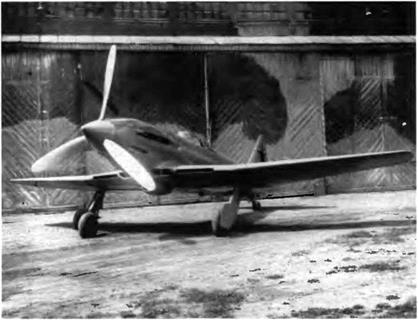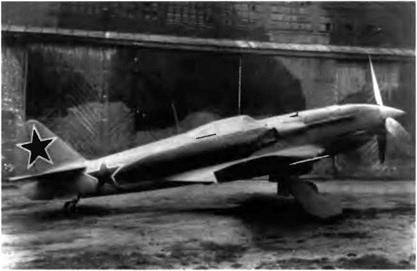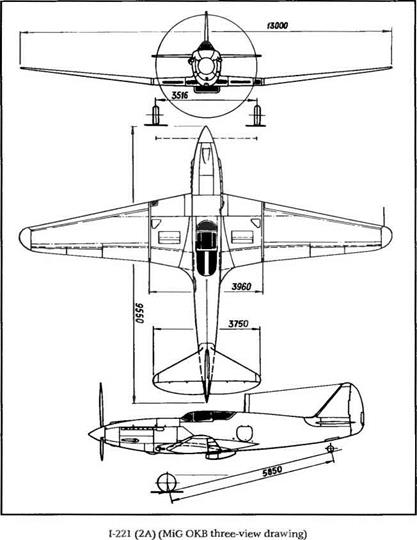1225/ 5A
The 1-225—last model of the A series, coded 5A—was the heaviest and most powerful experimental interceptor of the family. Its preliminary design was drawn up by a team of engineers headed by A. G. Brunov, project manager. Two I-225s were built in a back-to-basics formula: they had the same dimensions and wing area as the 1-220, the family’s progenitor. The 1-225 no. 01 was powered by an AM-42B engine, the no. 02 by an AM-42FB. The latter power plant provided 1,472 kW (2,000 ch) at takeoff or 1,288 kW (1,750 ch) at rated altitude and also at 7,500 m (24,600 feet). There was a TK-300B exhaust-driven turbosupercharger on its right side, and it drove a three-bladed AV-5A-22V propeller 3.6 m (11 feet, 9.7 inches) in diameter. The problems that plagued the 1-222 and 1-224 pressurized cockpit were solved, and the
|
|
|
|
Two l-225s were built (our photographs show no. 01). The exhaust-driven turbosupercharger was located on the right side of the engine. These aircraft were powered by the most powerful Soviet engine: the AM-42B, delivering 1,470 kW (2,000 ch) at takeoff.
size of the heat exchanger placed under the back of the engine was reduced.
Protection for the pilot was enhanced by the addition of 9-mra thick armor plate to the back of the seat, and the front and rear parts of the canopy were fitted with 64-mm thick bulletproof glass. The cockpit was equipped for instrument flying and had an ultrashort – wave transceiver.
The armament on both prototypes comprised four synchronized 20-mm ShVAK SP-20 cannons (100 rpg), two mounted above the engine and one fitted on each side. The 1-225 no. 01 built in June 1941 was a direct descendant of the 1-220 and made its first flight on 21 July 1944 with A. P. Yakimov at the controls. According to design calculations the aircraft ought to have reached 729 km/h at 8,520 m (394 kt at 27,945 feet) at engine combat rating and 721 km/h at 8,850 m (389 kt at 29,030 feet) at rated power. On 7 August 1944 Yakimov clocked up 707 km/h at 8,500 m (382 kt at 27,880 feet) at rated power. Two days later, on its fifteenth flight, the plane experienced engine failure near the ground and crashed, damaged beyond repair.
A second prototype was ordered. However, by the time the 1-225 no. 02 commenced flight tests on 14 March 1945 the MiG ОКБ had turned its attention to the 1-220 (N) and its motokompressor. In tests the 1-225 no. 02 earned the title of second-fastest Soviet piston-engine fighters at 720 km/h (389 kt)—unable to beat the record established on 19 December 1944 by the much lighter Yak-3U (2,830 kg/6,235 lb) powered by a 1,325 kW (1,800 ch) Klimov VK-108.
The 1-225 ended all attempts to design a successor for the MiG-3 based on a single layout or structural design. Every member of the MiG fighter family from the 1-200 to the 1-225 fell victim to endless troubles with its power plant. Besides, after five years of continuous development the maximum speed of this aircraft type had increased by only 80 km/h (43 kt).
Specifications
Span, 11 m (36 ft 1 in); length, 9.603 m (31 ft 6.1 in); height in level flight position, 3.7 m (12 ft 1.7 in); wheel track, 3.652 m (11 ft 11.8 in); wheel base, 5.85 m (19 ft 2.3 in); wing area, 20.38 mz (219.37 sq ft); empty weight, 3,010 kg (6,635 lb); takeoff weight, 3,900 kg (8,595 lb); fuel, 350 kg (770 lb); oil, 41 kg (90 lb); wing loading, 191.2 kg/m2 (39.18 lh/sq ft); max operating limit load factor, 8.
Performance
Max speed, 720 km/h at 8,500 m (389 kt at 27,880 ft); max speed at sea level, 590/617 km/h (319/333 kt); climb to 5,000 m (16,400 ft) in 4.5 min; service ceiling, 12,600 m (41,330 ft); landing speed, 134 km/h (72
|
|
kt); range, 1,300 km (810 mi); takeoff roll, 257 m (843 ft); landing roll, 450 m (1,475 ft).













